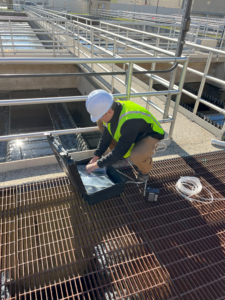Odor Studies: The Foundation for Effective Odor Management
In industrial and municipal settings, managing odors effectively is a challenge that requires precision, expertise, and a deep understanding of the unique environmental factors at play. Odor issues can significantly impact the surrounding community, leading to complaints, regulatory challenges, and even potential health concerns. This is where comprehensive odor studies come into play. At Webster Environmental Associates, Inc. (WEA), we specialize in conducting thorough odor studies that form the cornerstone of effective odor control strategies. With over four decades of experience and a proven track record, WEA ensures that your facility not only meets but exceeds odor management goals.
 The Importance of Odor Studies
The Importance of Odor Studies
Odor studies are the critical first step in any successful odor control program. These studies provide a detailed understanding of the specific odor sources, their intensity, and their potential impact on the surrounding environment. Without this foundational knowledge, any odor control measures implemented could be ineffective, leading to continued odor issues and unnecessary expenses.
At WEA, we approach odor studies with a combination of advanced technology, scientific rigor, and practical experience. Our goal is to provide you with accurate, actionable data that will inform every subsequent step in your odor control efforts, from technology selection to system design and implementation.
The WEA Approach to Odor Studies
Our approach to odor studies is both comprehensive and customized. We understand that no two facilities are the same, and we tailor our studies to the unique characteristics and needs of each client. Here’s how we do it:
Identifying Odor Sources
The first step in an odor study is to identify all potential sources of odors within the facility. This could include anything from wastewater treatment processes, industrial production lines, or waste handling areas. At WEA, we use a combination of on-site inspections, input from facility staff, and review of operational data to pinpoint these sources accurately.
Our team deploys specialized equipment to measure odor levels at various points throughout the facility. This includes both air and liquid sampling, allowing us to detect even trace amounts of odor-causing compounds. By understanding exactly where the odors are coming from and what compounds are involved, we can develop a targeted strategy to address them.
Measuring Odor Intensity and Impact
Once the sources are identified, the next step is to measure the intensity of the odors and their potential impact on the surrounding environment. This is done through a series of tests and analyses, including odor panel assessments, hydrogen sulfide (H2S) monitoring, and volatile organic compound (VOC) testing.
Odor panels are particularly valuable in this process. These panels, made up of trained human assessors, evaluate the odor samples to determine the detection threshold, recognition threshold, and intensity. This human element is crucial because it replicates how the odors would be perceived by the community surrounding the facility.
In addition to panel testing, we use advanced instruments to monitor the concentration of specific compounds, such as H2S and VOCs, which are often the primary culprits in odor complaints. Continuous monitoring equipment may also be deployed to capture data over extended periods, providing a more comprehensive view of odor fluctuations and trends.
Air Dispersion Modeling
To understand the broader impact of the odors on the surrounding area, WEA employs air dispersion modeling. This process uses sophisticated software to simulate how odors spread from the facility under different meteorological conditions. The model takes into account factors such as wind speed, direction, temperature, and topography to predict where and how far odors will travel.
Air dispersion modeling is essential for determining the extent of the odor problem and for identifying areas that are most likely to be affected. It also helps in designing odor control systems that are not only effective at the source but also prevent odors from impacting nearby communities.
Developing Data-Driven Solutions
The data collected during the odor study forms the foundation for developing effective odor control strategies. At WEA, we believe that every solution should be data-driven, ensuring that it directly addresses the specific issues identified during the study. This approach not only increases the effectiveness of the odor control measures but also ensures that resources are used efficiently.
Our team analyzes the results of the odor study to determine the best course of action. This could involve selecting the appropriate odor control technologies, such as biofilters, chemical scrubbers, or carbon adsorbers, and designing a system that integrates seamlessly with the existing facility infrastructure. We also provide recommendations for operational changes that could reduce odor emissions, such as modifying process parameters or improving maintenance practices.
Customizing Solutions for Long-Term Success
One of the key strengths of WEA’s approach to odor studies is our commitment to customization. We understand that every facility has unique challenges, and our solutions are always tailored to meet those specific needs. Whether your facility is a wastewater treatment plant, an industrial processing site, or a solid waste handling facility, we have the expertise to develop a solution that works.
 Our customized approach extends beyond the initial design and implementation. We provide ongoing support to ensure that the odor control measures remain effective over time. This includes regular monitoring, maintenance services, and adjustments as needed to adapt to changing conditions or new operational requirements.
Our customized approach extends beyond the initial design and implementation. We provide ongoing support to ensure that the odor control measures remain effective over time. This includes regular monitoring, maintenance services, and adjustments as needed to adapt to changing conditions or new operational requirements.
The Long-Term Benefits of a Thorough Odor Study
Investing in a comprehensive odor study with WEA offers significant long-term benefits. By identifying and addressing odor issues at the source, you can prevent future complaints, reduce regulatory risks, and protect your facility’s reputation. Additionally, effective odor control can improve the overall working environment, leading to increased employee satisfaction and productivity.
Moreover, a thorough odor study can help you avoid the costly mistakes associated with poorly designed or implemented odor control systems. By basing your odor management strategy on solid data, you can ensure that your investment in odor control is both effective and efficient.
Partner with WEA for Your Odor Study Needs
When it comes to managing odors, there’s no substitute for expertise and experience. At Webster Environmental Associates, Inc., we have both in abundance. Our team is dedicated to helping you achieve your odor control goals through comprehensive, data-driven odor studies. With our tailored approach, you can trust that your facility will be equipped with the most effective and efficient odor control solutions available.
Contact Webster Environmental Associates, Inc. Today
If you’re ready to take the first step toward effective odor management, contact Webster Environmental Associates, Inc. (WEA) today. Our experienced team is here to provide the comprehensive odor study services you need to ensure a successful outcome. Reach out to us and let’s work together to create a cleaner, more pleasant environment for your facility and the surrounding community.
